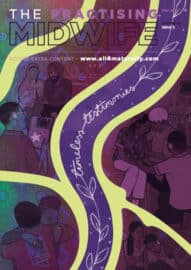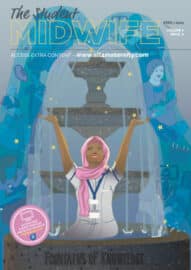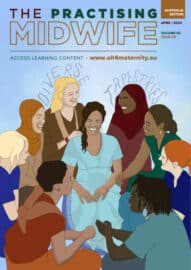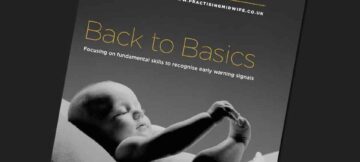Maternity Care for LGBTQ+ People – How can we do better?
Bunty Lai-Boyd – Practice Development Midwife, Gloucestershire Hospitals NHS Foundation Trust
@radical_midwife
Summary
This month is Pride Month. Pride month takes place every year in June as a nod to the Stonewall Riots which took place in June 1969. I would usually be celebrating – celebrating the uniqueness of my family; celebrating friends who are a part of the LGBTQ+ community; celebrating my LGBTQ+ colleagues. As much as the community love to celebrate our contribution to society, it is also an opportunity to peacefully protest and raise awareness of the discrimination that LGBTQ+ people face on a daily basis. Midwifery is undoubtedly a political profession and inclusivity should be at the heart of this.
Introduction
Although I am disappointed to not be joining my Trust in the local Pride march this year with my family, I am more disappointed to read the shocking statics provided by the ‘LGBT in Britain: Health Report’1:
- One in eight LGBT people (13 per cent) have experienced some form of unequal treatment from healthcare staff because they’re LGBT.
- One in seven LGBT people (14 per cent) have avoided treatment for fear of discrimination because they’re LGBT.
- Almost one in four LGBT people (23 per cent) have witnessed discriminatory or negative remarks against LGBT people by healthcare staff. In the last year alone, six per cent of LGBT people – including 20 per cent of trans people – have witnessed these remarks.
It is concerning that in 2020 we still see a rhetoric that demonstrates a level of discrimination preventing LGBTQ+ people from accessing much needed healthcare through fear of judgement. If we want to understand how to eradicate this, we have to understand why it happens. As a gay woman who has accessed care within and works for the NHS, I have had positive and negative experiences regarding my sexuality. At times I am able to use these negative experiences as a way to disseminate misconceptions – many of which come from a place off benign ignorance and not malice. I have however been subject to homophobia which has left me unsettled and upset.
LGBTQ+ people in maternity
 Historically the LGBTQ+ community have struggled to access healthcare – reiterated by the 14% of LGBTQ+ people who avoid healthcare altogether for fear of discrimination. Maternity care is arguably more daunting due to the very nature of childbearing culminating in a sense of emotional vulnerability. Being part of the LGBTQ+ community adds a dynamic to this which amplifies a sense of psychological and physical vulnerability. With advancements in new legislation and access to fertility services we are seeing more LGBTQ+ people creating families.2 Yet the structures of maternity are still described by the community and allies as heterocentric – a system which focusses primarily on heterosexual people and relationships.3We could argue this is no longer appropriate when 880 people (5%) who responded to the ‘2018 Survey of women’s experiences of maternity care report’ conducted by the Quality Care Commission did not identify as heterosexual.4 This is most likely a underestimated statistic when there is still much uncertainty about sexuality and gender disclosure if you are not a cisgendered* heterosexual individual.5 This information determines that there is a failing – that LGBTQ+ people do not feel represented by the current health system. As healthcare practitioners we are nurtured to be pragmatic: see a problem, find the solution, solve the problem. This area of concern should be tackled with the same pragmatic.
Historically the LGBTQ+ community have struggled to access healthcare – reiterated by the 14% of LGBTQ+ people who avoid healthcare altogether for fear of discrimination. Maternity care is arguably more daunting due to the very nature of childbearing culminating in a sense of emotional vulnerability. Being part of the LGBTQ+ community adds a dynamic to this which amplifies a sense of psychological and physical vulnerability. With advancements in new legislation and access to fertility services we are seeing more LGBTQ+ people creating families.2 Yet the structures of maternity are still described by the community and allies as heterocentric – a system which focusses primarily on heterosexual people and relationships.3We could argue this is no longer appropriate when 880 people (5%) who responded to the ‘2018 Survey of women’s experiences of maternity care report’ conducted by the Quality Care Commission did not identify as heterosexual.4 This is most likely a underestimated statistic when there is still much uncertainty about sexuality and gender disclosure if you are not a cisgendered* heterosexual individual.5 This information determines that there is a failing – that LGBTQ+ people do not feel represented by the current health system. As healthcare practitioners we are nurtured to be pragmatic: see a problem, find the solution, solve the problem. This area of concern should be tackled with the same pragmatic.
Understanding barriers
Golderg6 identified that healthcare professionals felt it was beneficial to treat LGBTQ+ parents in the exact same way as they would heterosexual parents. Although superficially this seems inclusive and helpful, it is actually counterproductive. A more desirable approach would be individualised care – care which reflects unique needs. It may also be useful to provide specific information leaflets or groups for LGBTQ+ parents in order to promote life-long friendships with other LGBTQ+ families and a sense of belonging.7 There is also an urgent need to address the language we use in maternity – avoiding the use of non-inclusive terms or gendering without asking for preferred pronouns. The booking process alone, used to gain access to maternity support, is problematic – with LGBTQ+ people having to negotiate difficult questions such as “what are the father’s details?”. We haven’t even touched on the glaringly problematic issue of being unable to register a man/male as pregnant on electronic records systems…
Then there is the dilemma of the distinct lack of maternity guidelines and polices which reflect the individual needs of the LGBTQ+ community. This is both a local and national issue. There are two major downfalls created by this; One is that LGBTQ+ feel underrepresented by the lack of inclusive guidelines; The second is that midwives do not feel equipped and confident in providing care for LGBTQ+ people without it.8 Since the implementation of the Equality Act in 2010 the NHS has a legal obligation to take steps towards creating a more inclusive and LGBTQ+ friendly organisation. One could argue that an appropriate starting point would be to address the lack of clinical and operational guidelines specific to maternity care for LGBTQ+ parents.
Improving the system
 Reviewing the evidence, it is disappointing to see that there has been little qualitative research focusing on LGBTQ+ people’s views of maternity care within the UK. The small amount of research there is primarily focusses on lesbian couples and the exploration of trans/queer people’s childbearing experiences is even less so. The sparse information we do have consists of small inclusion numbers and consequently does not provide organisations with a solid representation to base restructures of services on. Identifying themes within the literature of what the community want and need from their healthcare professionals is pivotal to overcoming this. Lesbian parents want to both be addressed as mothers9; they want healthcare to be individualised with consideration of their unique needs10; They want further education for midwives regarding the politics of diversity for LGBTQ+ parent.11 By listening and learning from the LGBTQ+ community maternity services can begin to make positive steps towards creating a more inclusive healthcare system. It may even be beneficial for organisations to develop the role of a LGBTQ+ inclusivity lead midwife so that an individual can dedicate their time and resources to improvements.
Reviewing the evidence, it is disappointing to see that there has been little qualitative research focusing on LGBTQ+ people’s views of maternity care within the UK. The small amount of research there is primarily focusses on lesbian couples and the exploration of trans/queer people’s childbearing experiences is even less so. The sparse information we do have consists of small inclusion numbers and consequently does not provide organisations with a solid representation to base restructures of services on. Identifying themes within the literature of what the community want and need from their healthcare professionals is pivotal to overcoming this. Lesbian parents want to both be addressed as mothers9; they want healthcare to be individualised with consideration of their unique needs10; They want further education for midwives regarding the politics of diversity for LGBTQ+ parent.11 By listening and learning from the LGBTQ+ community maternity services can begin to make positive steps towards creating a more inclusive healthcare system. It may even be beneficial for organisations to develop the role of a LGBTQ+ inclusivity lead midwife so that an individual can dedicate their time and resources to improvements.
Conclusion
The system is not going to change overnight but by working together as an organisation we can make improvements which will ultimately have a positive impact on the experiences of LGBTQ+ people in maternity. Simple and inexpensive interventions such as creating maternity guidelines specific to LGBTQ+ people will create an inclusive structure where people feel comfortable accessing care (although we must be vigilant to consult and include LGBTQ+ people in re-structuring and developments). As an individual practitioner you can also make steps towards becoming more inclusive by gaining knowledge regarding maternity care for LGBTQ+ people – this is debatably part of the continuum of evidence-based learning and encompasses the NMC code; read articles and books or ask the community in a respectful manner when the opportunity arises. Until all LGBTQ+ people feel comfortable accessing healthcare there should be a habitual drive to listen, learn and adapt.
Key points
- More qualitative research in this area will aid a better understanding of what LGBTQ+ parents want from their healthcare professionals.
- Providing maternity training specific to LGBTQ+ people will improve inclusivity.
- Using inclusive language and addressing discriminative language will make LGBTQ+ people feel more comfortable in maternity.
- Individualised care is pivotal in improving experiences for LGBTQ+ parents.
- Development of a LGBTQ+ inclusivity lead midwife is an area for consideration in the NHS.
*Cisgendered: of, relating to, or being a person whose gender identity corresponds with the sex the person had or was identified as having at birth.
Useful online resources
https://maternityaction.org.uk/advice/same-sex-partner/
https://lgbt.foundation/piptrainingacademy
https://www.stonewall.org.uk/sites/default/files/stonewall-guide-for-the-nhs-web.pdf
1 Bachmann C, Gooch B. LGBT in Britain: Health Report. https://www.stonewall.org.uk/system/files/lgbt_in_britain_health.pdf. Published Nov, 2018. Accessed June 3, 2020.
2 McManus A, Hunter L, Renn H. Lesbian experiences and needs during childbirth: guidance for health care providers. J Obstet Gynecol Neonatal Nurse. 2006;35(1):13–23. doi:10.1111/j.1552-6909.2006.00008.x.
3 Cherguit J, Burns J, Pettle S, Tasker F. Lesbian co-mothers’ experiences of maternity healthcare services. J Adv Nurs. 2013;69(6):1269‐1278. doi:10.1111/j.1365-2648.2012.06115.x
4 Care Quality Commission. 2018 Survey of women’s experiences of maternity care. https://www.cqc.org.uk/sites/default/files/20190424_mat18_statisticalrelease.pdf. Published Jan 2019. Accessed June 3, 2020.
5 Dibley LB. Experiences of lesbian parents in the UK: interactions with midwives. Evidence Based Midwifery2009;7 (3):94-100
6 Goldberg L, Harbin A, Campbell S. Queering the birthing space: Phenomenological interpretations of the relationships between lesbian couples and perinatal nurses in the context of birthing care. J Sex and Wales by Characteristics of Mother. 2011;14 (1):173-192. doi:10.1177/1363460711399028
7 Röndahl G, Bruhner E, and Lindhe J. Heteronormative communication with lesbian families in antenatal care, childbirth and postnatal care. Journal of Advanced Nursing. 2009;65 :2337-2344.
8 Fish J. Conceptualising social exclusion and lesbian, gay, bisexual and transgender people: the implications for promoting equity in nursing policy and practice. J Res Nurs. 2010;15 (4):303–12. doi.org/10.1177/1744987110364691
9 Appelgren Engström H, Häggström-Nordin E, Borneskog C, Almqvist AL. Mothers in same-sex relationships-Striving for equal parenthood: A grounded theory study. J Clin Nurs. 2019;28(19-20):3700‐3709. doi:10.1111/jocn.14971
10 Lee E. Lesbian users of maternity services: appropriate care. British Journal of Midwifery. 2004;12(6): 353–358. doi.org/10.12968/bjom.2004.12.6.13132
11 Wilton T, Kaufmann T. Lesbian mothers’ experiences of maternity care in the UK. Midwifery. 2001; 17(3):203-11. doi:10.1054/midw.2001.0261.










Pingback: Supporting LGBT+ Breastfeeding and Chestfeeding… By Steph Gale. – B.E.S.T CIRENCESTER